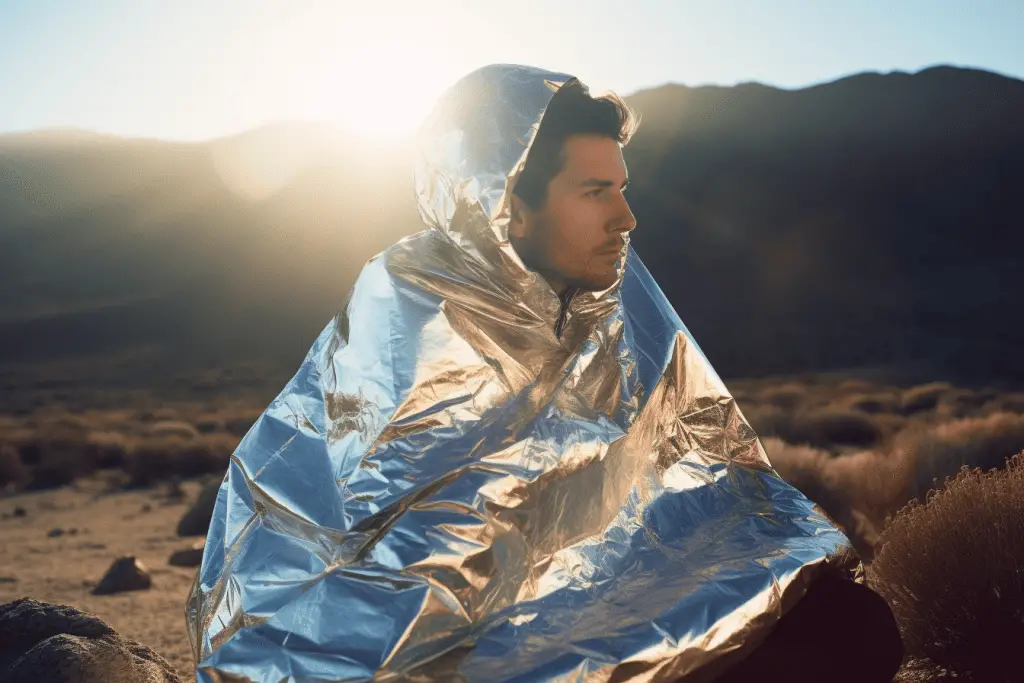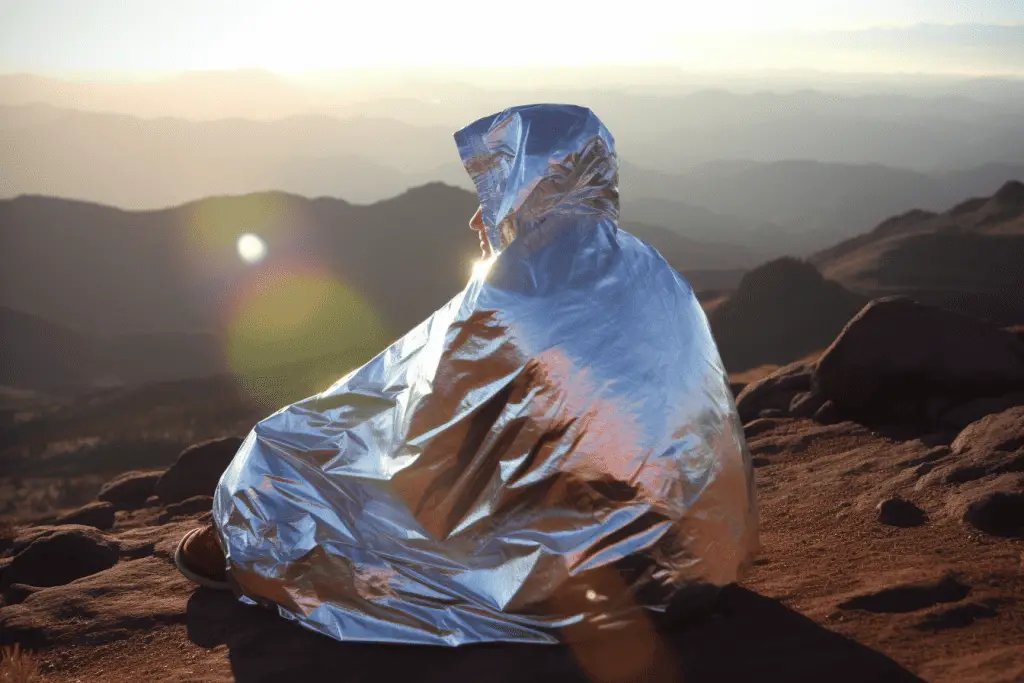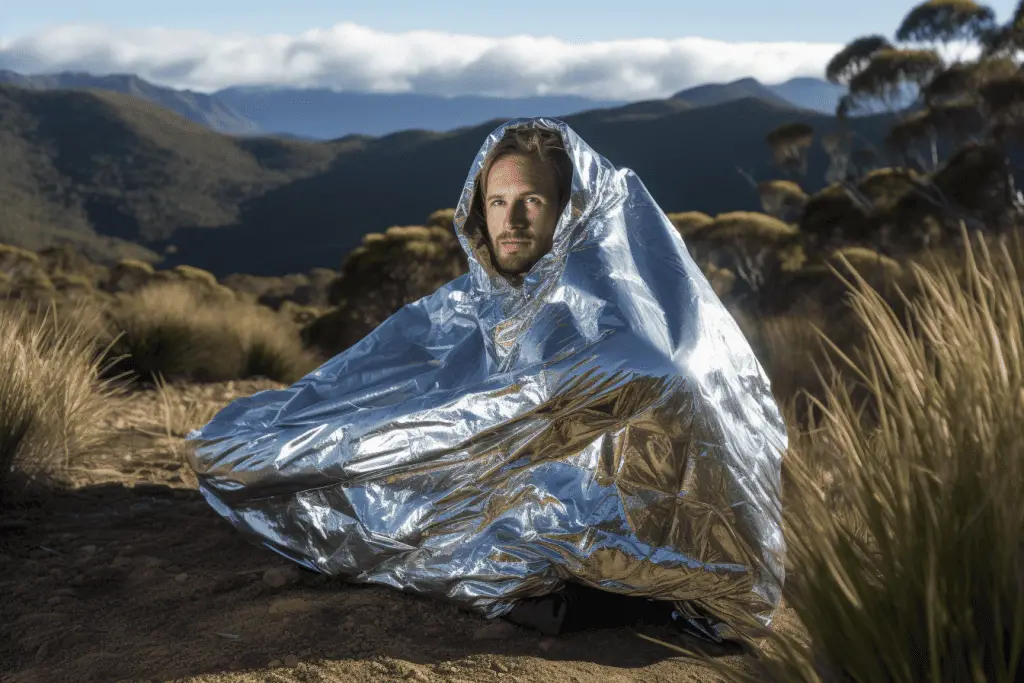We all know that an emergency blanket is a must-have item for any outdoor enthusiast. But how do emergency blankets work?
Emergency blankets, also known as space blankets, work by reflecting a person’s body heat back to them. The blanket is made of a thin, lightweight material that is coated with a metallic layer, which reflects up to 90% of a person’s body heat. This helps to keep the person warm in emergency situations, such as when stranded outdoors or in a car during cold weather.

A Glimpse into the Past: The Origin of Emergency Blankets
Ever wondered where these shiny lifesavers come from? Well, the story of emergency blankets actually begins way up above – in space! These blankets, also known as space blankets, were first developed by NASA in 1964 for the US space program. The objective was to protect spacecraft and astronauts from the extreme temperature fluctuations in space.
The material used, known as Mylar, is super lightweight, reflective, and has fantastic insulative properties. These qualities made it perfect for space travel, but it didn’t take long for its potential to be recognized for earthly applications, especially in the field of outdoor survival.
By the late 20th century, these shiny gold or silver blankets started showing up in emergency kits worldwide. Today, they’re a common sight in marathons, on mountaintops, and in the backpacks of adventurers everywhere. Not just confined to outdoor activities, they’ve even found their place in humanitarian relief efforts, helping to save lives in disaster-stricken areas.
The story of the emergency blanket is one of innovation and adaptation. Born out of a need for survival in the harsh conditions of space, these blankets have come to be an essential tool for protection and safety right here on our own planet. Next time you’re packing your gear, remember, you’re carrying a piece of space history with you!
Emergency Blankets for Hiking: Survival and First Aid Applications
Alright, so you’re heading out on a hiking trip, your backpack filled with all the essentials – water, snacks, map, first-aid kit, and of course, your trusty emergency blanket. But you might be asking, how exactly can this lightweight item help in survival and first aid situations?
Let’s imagine you’re on a long day hike and the weather suddenly takes a turn for the worse. The temperature drops rapidly and you find yourself stranded, unable to make it back before nightfall. In this situation, an emergency blanket can be your best friend. The reflective material will help preserve your body heat, keeping hypothermia at bay until help arrives or conditions improve.

In more dire situations, emergency blankets can even be used in treating shock. If someone has sustained an injury and is showing signs of shock – like rapid heartbeat, shallow breathing, or cold, pale skin – wrapping them in an emergency blanket can help stabilize their body temperature and slow the progression of shock while you seek medical help.
But these blankets aren’t just about survival – they can also play a creative role in your outdoor adventures! You can use them as a makeshift shelter or ground cover, to signal for help in an emergency, or even as a water collector in survival situations.
Remember, having an emergency blanket and knowing how to use it are two sides of the same coin. Knowledge is power, so before your next hiking adventure, take some time to learn about all the incredible ways your emergency blanket can come to your aid. It’s a small piece of gear with a big impact!
How to Use an Emergency Blanket: Your Survival Guide
So, you’ve packed your emergency blanket for your next outdoor adventure – great! But knowing how to use it effectively can be just as important as having it in the first place. Let’s break it down together, step by step.
Firstly, it’s crucial to know when to use your blanket. It’s not meant to replace your cozy sleeping bag during planned camping nights. Instead, it’s there for unexpected situations – when the weather turns bad, if you’re stranded overnight, or if you or someone else is showing signs of hypothermia or shock. In these scenarios, the blanket’s heat-reflective properties can be a lifesaver.
To use the blanket, simply open it up and wrap it around your body. Ensure it covers as much of you as possible, particularly your torso where most body heat is lost. If you can, layer it over your clothes rather than directly on your skin, as sweat can reduce its effectiveness.
Remember, these blankets are designed to reflect heat back to the source. That means if you’re in a survival shelter or tent, you can line the inside with your blanket to reflect your body heat back to you, creating a warmer environment.
Lastly, creativity can go a long way! Apart from keeping you warm, emergency blankets can also be used to signal for help, as their reflective surface is visible from a distance. And in a pinch, they can serve as a makeshift shelter, rain cover, or ground sheet.
How To Safely Use An Emergency Blanket
While emergency blankets are truly remarkable, it’s important to remember that they aren’t magic. They’re a tool, and like any tool, they come with their own set of safety considerations and potential limitations. Let’s look at some key points to keep in mind.
Firstly, emergency blankets are not breathable. This means that while they’re excellent at reflecting heat, they can also trap moisture. If you’re wrapped in one for a long period of time, especially if you’re sweating or wet, this trapped moisture can actually make you colder. To mitigate this, try to dry off as much as possible before using the blanket, and if you can, layer it over your clothing instead of having it directly against your skin.

Secondly, remember that the blanket’s primary function is to reduce heat loss, not necessarily to make you warm. If you’re already cold, it will help keep you from losing more heat, but it may not be enough to fully warm you up. Therefore, it’s vital to combine the use of an emergency blanket with other methods of warming up, like physical activity, eating high-energy foods, or finding or creating a shelter.
Finally, while they can be used as a makeshift shelter in a pinch, emergency blankets are quite thin and can easily tear in high winds or when snagged on sharp objects. So handle them with care, and if you’re using one as a shelter, try to reinforce it or protect it as much as possible.
How To Store An Emergency Blanket
So, you’ve learned about the history, uses, and safety considerations of your emergency blanket. Now let’s talk about how to store an emergency blanket.
Emergency blankets can be easily folded or rolled up for storage. It is recommended to store them in a cool, dry place away from direct sunlight and moisture. Some people choose to keep them in their car or emergency kit for easy access in case of an emergency.
Can You Reuse Emergency Blankets?
Despite being incredibly tough for their weight, emergency blankets are usually designed to be disposable and are not typically meant for repeated use. That said, if you’re careful with it, you can certainly get more than one use out of a blanket. After use, try to clean it gently with a damp cloth to remove any dirt or debris, dry it thoroughly, and then fold it back up carefully.
Storing An Emergency Blanket
The key to storing your emergency blanket is to keep it easily accessible. This means having it somewhere in your backpack where you can grab it quickly if the weather turns or an emergency arises. However, avoid storing it somewhere it could get punctured, like near sharp tools or equipment.
When it comes to folding your blanket, the goal should be to get it as compact as possible without damaging it. Try to follow the original folds if you can, as this will make it easier to pack away. If you’re having trouble, don’t worry too much – the most important thing is that it’s packed away cleanly and ready to be used when needed.
Remember, an emergency blanket is like any piece of outdoor gear – its usefulness is directly tied to how well you take care of it. Treat it with respect, store it properly, and it’ll be there for you when you need it the most.
In Conclusion: The Vital Role of Emergency Blankets in Your Outdoor Gear
As we’ve explored, emergency blankets, despite their simplicity and lightweight nature, play a significant role in outdoor activities. Born from the need to protect astronauts in the challenging environment of space, these blankets have proven their worth time and time again right here on Earth – on hiking trails, mountaintops, and in countless survival scenarios.
These shiny lifesavers have shown their worth in the most extreme conditions, and yet, they’re small and light enough to accompany you on even the shortest day hike. From reflecting heat and warding off hypothermia to being repurposed as a signal for help or a makeshift shelter, their utility goes far beyond what meets the eye.
But like any tool, they’re most effective when used correctly. Knowledge of their limitations, understanding how to use them effectively, and knowing how to care for them can greatly enhance their efficacy. It’s not just about carrying the blanket – it’s about knowing how to leverage it when you need it the most.
So as you pack your gear for your next outdoor adventure, take a moment to appreciate that small, shiny, lightweight blanket. It’s more than just a piece of gear; it’s a ticket to safer, more secure adventures. And who knows? This little piece of space technology might just turn out to be the most valuable item in your backpack.
